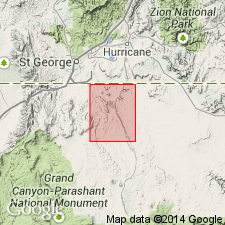
- Usage in publication:
-
- West Mesa Basalt*
- Modifications:
-
- Named
- Mapped 1:31,680
- Dominant lithology:
-
- Basalt
- AAPG geologic province:
-
- Plateau sedimentary province
Summary:
Named for occurrence at West Mesa which is designated as its type area and is located in T40N, Rs10,11W, northern Mohave Co, AZ, Plateau sedimentary province. Mapped in type area within west-central part of map area. Flows and associated volcanic deposits form top of West Mesa which is an inverted valley. Unit consists of three types of volcanic deposits each separately mapped: 1) Basalt flows--dark-gray finely crystalline basalt with aphanitic groundmass; large columnar joints are at base of some flows, but not common; flows are 1-35 m thick. 2) Intrusive dike or plug--dark-gray, finely crystalline, aphanitic basalt; weathers into crumbly small fragments due to abundant cooling joints; source vents for basalt flows. 3) Cinder and scoria deposits--red-brown to black clasts of angular or glassy fragments of basalt; form cinder cones and a thin cover on basalt flows; up to 30 m thick. Similar in lithology and elevation, though slightly older, as newly named East Mesa Basalt about 2 km to north. Basalt partly overlies alluvial deposits of ancestral Dutchman Draw paleodrainage at north end of West Mesa, but rests mostly on Timpoweap Member, lower red member, and Virgin Limestone Member of Moenkopi Formation and Harrisburg Member of Kaibab Formation. Younger than Pliocene Seegmiller Mountain and Black Rock Canyon Basalts (new). K-Ar whole rock age of 1.6 +/-0.3 Ma (Pleistocene) (Harold H. Mehnert, USGS, written commun., 1993).
Source: GNU records (USGS DDS-6; Denver GNULEX).
For more information, please contact Nancy Stamm, Geologic Names Committee Secretary.
Asterisk (*) indicates published by U.S. Geological Survey authors.
"No current usage" (†) implies that a name has been abandoned or has fallen into disuse. Former usage and, if known, replacement name given in parentheses ( ).
Slash (/) indicates name conflicts with nomenclatural guidelines (CSN, 1933; ACSN, 1961, 1970; NACSN, 1983, 2005, 2021). May be explained within brackets ([ ]).

